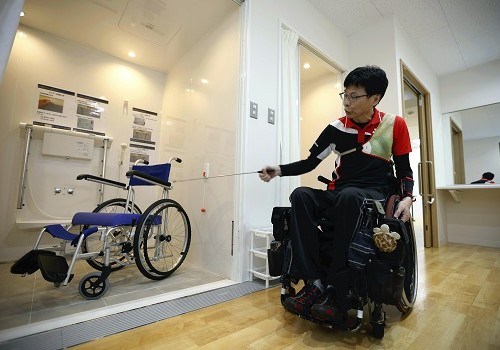August 30, 2022
TOKYO – Thanks in part to Tokyo’s hosting of the Paralympic Games last year, disabled athletes and the sports they compete in have been garnering increased public attention.
However, efforts to ensure practice-friendly, community-based environments for such athletes remain something of a work in progress.
With an eye on welcoming more disabled people to sports facilities, local governments have been drawing up pertinent manuals and fostering instructors who can facilitate stress-free practice sessions.
On Aug. 14, Toshihiro Shimoyama, a 54-year-old wheelchair-using company employee who lives in Katsushika Ward, Tokyo, took part in a mixed-ability archery session at Okudo Sogo Sports Center in the ward. Shimoyama sustained a cervical vertebra injury in a 1998 traffic accident and has used a wheelchair since. Over the past 15 years or so, he has practiced archery at the center once or twice a week as a member of a local archery club in the ward.
The center is open to people of all abilities, but ramps have been installed to make the facility barrier-free. Two years ago, larger-sized locker rooms and shower stalls were installed to make life easier for wheelchair users. Many disabled athletes, including people who enjoy playing wheelchair basketball, use the center.
“I’m thankful that such a wheelchair-friendly facility exists nearby,” Shimoyama said.

The Yomiuri Shimbun
Toshihiro Shimoyama explains about a special shower room for disabled users at Okudo Sogo Sports Center in Katsushika Ward, Tokyo, on Aug. 14.
Dearth of facilities
Yet, there are only a limited number of sports facilities that can properly accommodate the needs of disabled patrons.
According to a 2021 survey conducted by the Sasakawa Sports Foundation (SSF), Japan only has about 150 sports facilities used either exclusively or preferentially by people with a disability. This is a very small figure when set against the about 9.64 million people across the country who have a disability.
A 2021 Japan Sports Agency survey found that 31% of disabled adults practice a sport at least once a week. Though this marked a 6.1-percentage point increase from the preceding fiscal year — and a record high — it is far from the 40% figure targeted by the government.
Kazunari Obuchi, a policy director at SSF, said: “It’s unrealistic to markedly increase the number of disabled-only sports facilities. [Instead], we should make general gymnasiums more user-friendly for disabled users, similar to what the local government has done in Katsushika Ward.”
The Tokyo metropolitan government and the Saitama prefectural government have each drawn up manuals geared toward making facilities more user-friendly for disabled people. For example, to easily eliminate height differences in a shower room without undertaking heavy reform work, the manuals suggest the use of duckboards to create a more level surface.
The Nagano prefectural government places great emphasis on fostering instructors who can help disabled people enjoy sports practice without stress. The prefecture’s welfare center takes the lead in this respect, and the prefectural government certifies individuals who have attended classes and undergone practical training to deepen their knowledge and understanding to help support sports in their communities. So far, about 30 people have been certified for such leadership roles.
Efforts to improve facilities at private-run sports venues have been expedited to make it easier for them to accommodate the needs of people with a disability.
Central Sports Co., a Tokyo-based firm that operates about 240 sports and fitness facilities across the country, has installed ramps at the entranceways to many of its buildings.
One location in Chiba Prefecture holds mixed-ability swimming-practice sessions. At other facilities, meanwhile, efforts are made to make regular classes accessible to disabled patrons.
“As the population continues to gray, there will be a growing need for facilities that everyone can use,” Obuchi said. “Public- and private-run sports facilities alike should cooperate to create local networks that help improve relevant systems.”

